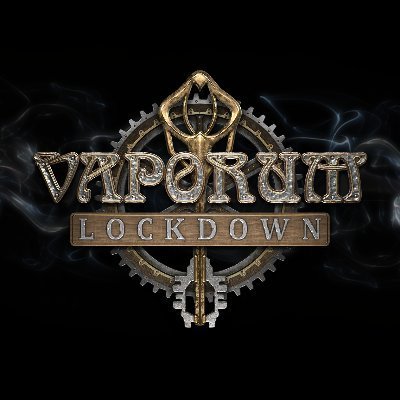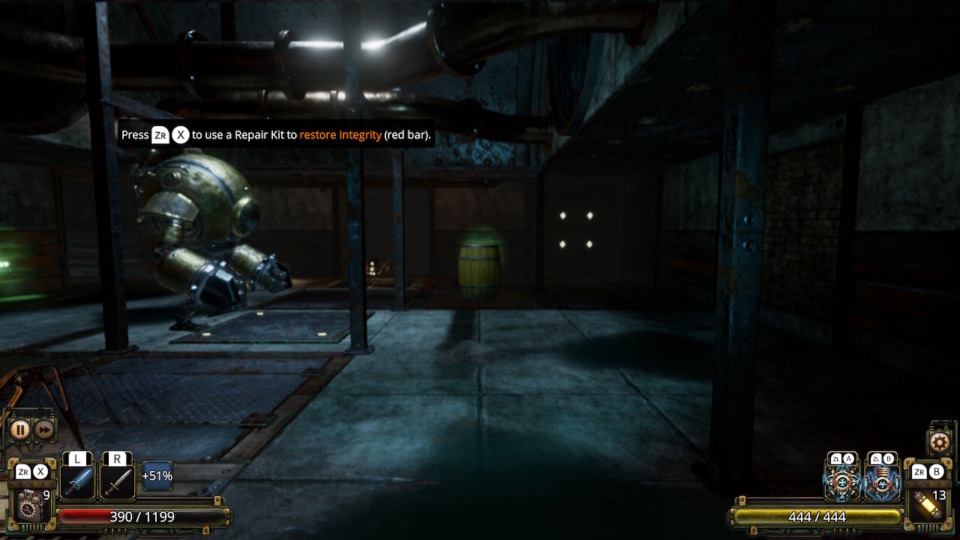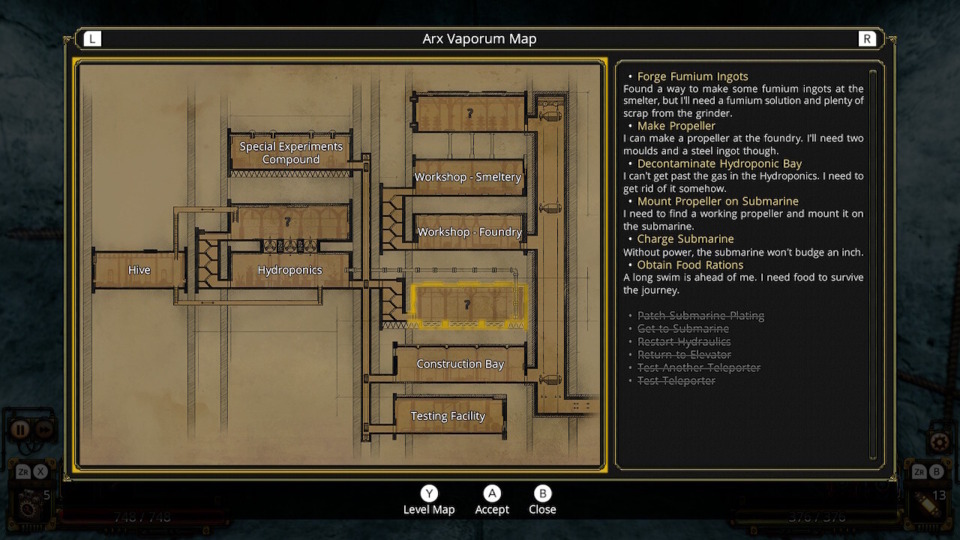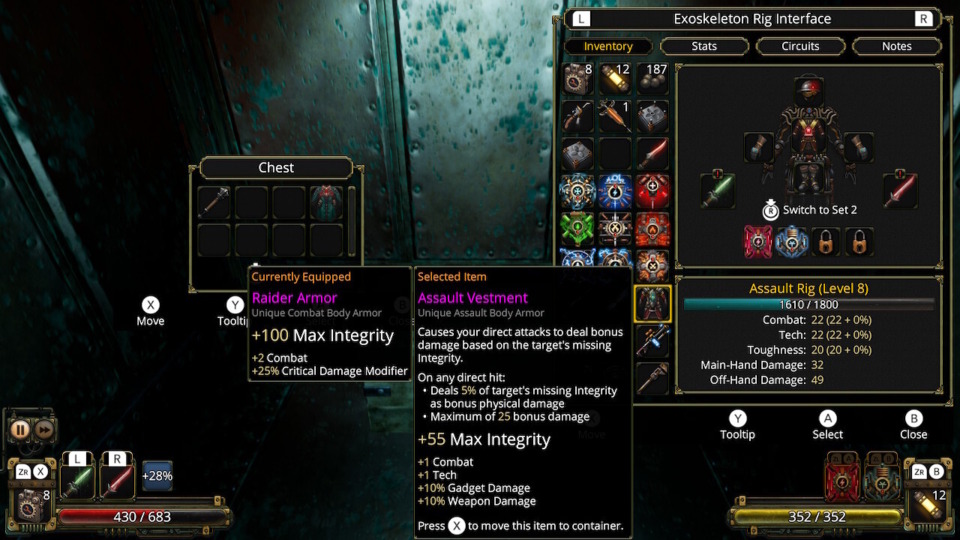
Prepare all your best Xbox Series X hardware jokes because we're gonna get vaporous this week. Vaporum: Lockdown is a sequel (or prequel, or interquel, or something) of 2017's Vaporum by Slovakian studio Fatbot Games, which I covered a couple of years back (IGotW #155). A steampunk-themed, first-person, single-character dungeon-crawler with real-time combat and movement and an emphasis on using weapons and cooldown-based gadgets to defeat a bunch of mutated drones and lab rats all hopped up on some uncanny alien substance fished up from the bottom of the ocean by now-dead scientists and engineers who should've known better. It's some BioShock by way of Legend of Grimrock, if you were looking for the reductive elevator pitch. Vaporum also happened to be one of my favorites in a very packed year of instant classics, so I've been itching to play this 2020 follow-up for some time.
The story of Vaporum: Lockdown is straightforward enough, though it might require some familiarity with the first game. The Arx Vaporum is a towering state-of-the-art research facility built on a remote island close to something called the "fumium core": an underwater depository of an unknown mineral that has proven very adaptive to the current era's steam-powered technology. The first game follows Marcus Rike, the director of the facility who was called back to government HQ to answer for some unorthodox experiments performed under his watch, as he returns to find Arx Vaporum in complete pandemonium and fights his way through legions of hostile creatures to uncover the truth of what happened and rescue any survivors. Lockdown is set between his departure and return (thus technically a prequel) and follows a new character: Ellie Teller, an idealistic post-grad prodigy poached by Lora Rike, the facility's head scientist and wife of Marcus, to work on her team's inchoate teleportation technology division. Teller quickly finds herself trapped by the sudden disaster and works to find a way off the island.

The most striking difference between the game and its predecessor is the slightly more open level structure. Whereas Vaporum had you moving steadily from one floor to the next without any reason to return to earlier zones, Vaporum: Lockdown has Ellie running all over the place in order to fix Arx Vaporum's sole remaining submersible craft. Being in an advanced state of disrepair, however, means Ellie has to visit several areas of the facility to track down the materials required to fix it up. It plays a little more like Dead Space in practice: it's a linear if circuitous course, directed by the story and a dripfeed of acquired key items and tech, that has you zipping from one area to the next and occasionally backtracking to previous locations that may have changed in the interim. Enemies are constantly becoming stronger to meet your own experience and equipment gains, presenting distinct challenges depending on their types.
This ties into Vaporum: Lockdown's second most significant evolution: a heavier prominence of elemental traits and abilities. The existence of burning, freezing, shocking, acid, and bleeding effects can significantly alter the way you approach certain enemies who can hit you with those debuffs, and likewise the player's combat strategies become subtly different when using these same debilitations against enemies. This is best demonstrated with the opposing burning and bleeding effects: fire does more damage over time if the recipient is standing still, though they can end the burning effect faster by moving around; conversely, bleeding damage is exaggerated when moving around, so you're encouraged to stand still and ride its duration out if possible. If you happen to have a weapon with a bleeding effect, then, you're best off adopting a "hit and run" tactic where your enemies bleed out pursuing you. The game still has that Dungeon Master duck-and-weave aspect to its combat, sometimes known as the "combat waltz," where constantly moving around enemies to avoid facing them and receiving their attacks is the ideal way to avoid damage while also providing ample opportunity to get in your own strikes. Both the player and certain enemies can also use firearms to attack from a distance and over pits, though with limited ammo this isn't a tactic you can rely upon for every encounter. Many enemies require special tactics to defeat: the laser cutter drones, for instance, have a persistent laser beam that can kill you in seconds if you're in constant contact, with the idea being that you keep maneuvering to their flank or around walls to avoid the beam at all costs. Many of the new enemies are also experts at controlling the environment, dropping pools of acid or fire everywhere to limit your movement and prevent the usual tactic of finding a square room and running around them in circles.

The game's various trap and puzzle rooms are equally deadly, and the game will occasionally (but not always) do you the solid of auto-saving before you attempt to tackle anything with insta-death pitfalls or gas chambers. To mitigate the difficulty of both these trap rooms and the enemy encounters, the player can optionally switch to a "turn-based" mode that freezes time whenever the player isn't moving or attacking, similar to a classic roguelike or the game Superhot. This especially helps with puzzle rooms that demand very strict timing - running between a stream of fireballs shooting down a hallway, for instance - which is difficult enough with mouse and keyboard controls and perhaps tougher still with the Switch's otherwise acceptably intuitive button controls. The player is well-rewarded for exploration though, not only acquiring improved gear on a regular basis but also many consumables that offer permanent stat boosts. I'm not sure if the game increases the drop rate of healing consumables if you start to run low but I half suspect it does because I've regularly found myself with the same reserve supply of around five or six, picking up new ones as I use them, while playing on the game's default difficulty. As a result, I would say that the standard challenge level, while high, is far from insurmountable. Per contra, I've also been dying a lot; the quicksave button has seen quite a workout since I started.
Vaporum: Lockdown's more dynamic progression structure and new combat complexities does elevate it a little over the original, but at the same time it feels very much beholden to that first game's framework. The similarities far outweigh new additions - almost everything mentioned above, including the turn-based mode, returns from Vaporum and its UI is almost identical - which robs Lockdown of much of its own personality and distinctiveness, often leading to it feeling more like a DLC expansion than a full sequel. One aspect that has benefitted from this sequel process however is the series' focus on epistolary storytelling, giving you the perspective of a dozen or so NPCs via their abandoned audio logs and written missives. It's been too long since my Vaporum playthrough to recall how many of these names were featured in both games, besides major characters like the Rikes, but they do an interesting job in delivering backstory in a mostly achronological fashion. You'll often find the journals of characters staring imminent death in the face with panicked notes about noises in the vents, only to find another article from the same party complaining about the overly restrictive safety protocols enacted by the director and how impatient they are to tinker around with forces beyond their control. The notes aren't necessarily meant to be read in a specific order, I think, since many are only found off the beaten path in optional chests and lockers, but you do start to see arcs evolve with specific characters as you go on. Discovering that a colleague had been relegated to being a guinea pig after a mishap, emotionally and physically altered by their continued exposure to fumium, and then encountering that same insane, superpowered NPC in the flesh as he psychically taunts you was an effective evolution of that character, though with most NPCs they're long-dead by the time you find their records.

I am definitely enjoying my time with Vaporum: Lockdown, as I suspected I would after a similarly positive experience with its predecessor. That it feels very similar isn't wholly a negative if it means replicating the same high degree of quality for its exploration, storytelling, and the meaningful (and often spooky) encounters with its intelligent, vicious foes. Having you backtrack to older areas with new progress-enabling gear or key items isn't so much a detriment but a way to give this facility a little more internal logic and consistency - even if it goes unexplained why such a place filled with scientists has so many pits and fireball traps - as does giving the protagonist a very clear directive (escape!) early on and spending the majority of the game slowly working towards completing it, one resolved issue at a time. I'm feeling like I probably should've picked a class that better exploits the newer elemental mechanics - you have a choice early on between four "exo-rigs" that determine stat growth and areas of expertise, effectively working like class builds - but my zippy, dual-dagger-wielding fighter with her "offense is the best defense" philosophy has been eking her way through just fine so far, as would the various other build choices offered by the many weapon and gadget types I keep finding. The new energy guns, which draw directly from the player's mana pool rather than finite bullets, might've also been a wise choice for a more tech-focused character too. The grass is always greener, huh? Either way, I'm looking forward to finishing it off sometime this weekend, provided they stop throwing those darn laser cutter drones at me. If I've learned anything about lasers over the past couple of days, it's that they hurt. A lot.
Rating: 5 out of 5.
| < Back to 261: Kelvin and the Infamous Machine | The First 100 | The Second 100 | > Forward to 263: Inbento |

Log in to comment